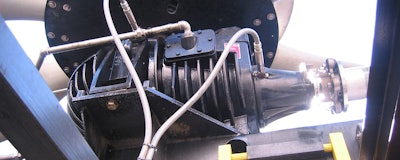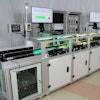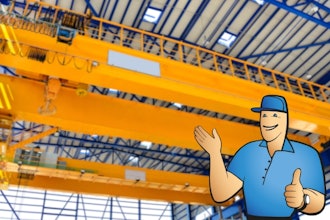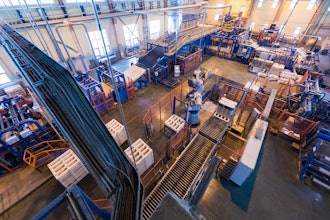
 Mark Groothuis, SPX Cooling Technologies Product Manager – Controls
Mark Groothuis, SPX Cooling Technologies Product Manager – ControlsAs a piece of machinery operates, it vibrates. If measured and analyzed, the frequency and amplitude of this vibration can provide insight into the machine’s condition. With the proper tools, these vibration signals can alert personnel, and even shut down the equipment when deteriorating conditions or events occur. Vibration monitoring equipment is available to aid in maintenance forecasting and help prevent damage to machinery and components.
The level of vibration management adequate for protecting the cooling tower and supported processes must be determined by the owner. The five options identified in this article can help monitor and protect cooling tower components from the potentially destructive effects of vibration.
Definitions
A basic understanding of components and vibration terminology is helpful in choosing an appropriate vibration monitoring option:
- A vibration analyst can identify the source of vibration based on its frequency (the rate at which it occurs) and determine its severity based on the amplitude (the amount of vibration).
- A transducer is a device that converts one form of energy into another.
- An accelerometer is a type of transducer commonly used in vibration measurement, which generates an electric charge proportional to the acceleration force applied to it. Accelerometers can be very sensitive and provide output signals for simultaneous occurrences.
- A velocimeter is a type of accelerometer that has on-board electronics to integrate the data into velocity units.
- A signal conditioner/transmitter is a solid-state, electronic device that can include an integral transducer or connect to a separate transducer. Its purpose is to convert the raw signal into an amplitude measurement proportional to the overall condition. It is useful for simplifying the signals for basic trending, alarm and/or shutdown. It is also useful if long cable runs are required to connect the transducers to an auxiliary system such as a plant SCADA (Supervisory Control and Data Acquisition) System or DCS (Distributed Control System).
- FFT (Fast Fourier Transform) converts a vibration waveform from the time domain (time versus amplitude) to the frequency domain (frequency versus amplitude). The results of this process substantially simplify the identification of the vibration frequencies and the associated amplitudes of each. A graphic example of the time waveform plot and the transformed spectrum data is shown in Figure 1.
- Vibration analysis is the process by which an analyst uses measured vibration responses to evaluate the condition of a system and make appropriate recommendations.
 Two accelerometer transducers are mounted on a gear drive near the low speed output/fan shaft (left) and the high-speed input shaft. This arrangement could be utilized as part of a vibration management program.
Two accelerometer transducers are mounted on a gear drive near the low speed output/fan shaft (left) and the high-speed input shaft. This arrangement could be utilized as part of a vibration management program. Figure 1
Figure 1Vibration Management Options
Option I: Mechanical Vibration Switch
A mechanical vibration switch is the simplest way to manage vibration. The switch is typically mounted onto the mechanical equipment support and connected to the motor starter circuit. If it realizes a vibratory event that exceeds the set-point (typically 1g), it will “trip.” These switches may be set up so that the trip initiates an alarm to alert system operators and/or automatically shut down the equipment.
Mechanical inertial switches “sense” acceleration in one direction. They are a good first step to potentially mitigate damage caused by excessive vibration, but they are not monitoring devices. They do not measure vibration or collect data; rather they react to a specified level of acceleration. In many instances, it may be too late to prevent failure; in such cases, the switch is intended to notify operators so they can inspect mechanical equipment and prevent further damage. Operators should wait until the issue is diagnosed before resetting the mechanical vibration switch.
Note: During cooling tower start-up, it is common for vibration levels to be temporarily elevated.
 A mechanical vibration switch, typically mounted onto the mechanical equipment support, is the simplest way to manage vibration.
A mechanical vibration switch, typically mounted onto the mechanical equipment support, is the simplest way to manage vibration.Option II: Electronic Vibration Switch
These switches have important advantages over mechanical switches. The upgraded solid-state, electronic versions utilize an accelerometer or velocimeter that more accurately measures the amount of vibration. The two-wire solid-state switches, combining power and control, can also be mounted on a gear drive to further ensure reliable sensing and collaborate well with variable frequency drives. Because the solid-state switch is hermetically sealed and cased in stainless steel, it can also better withstand harsh cooling tower conditions. In many electronic vibration switches, the transducer may be integral to the switch housing or external and connected to the switch by a cable. Some switches generate an overall, proportional signal (4-20 mA) for plant management connectivity to a DCS or SCADA system. Additionally, a BNC terminal allows the transducer’s raw signal to be transmitted to an analyzer.
Note: An important option for an electronic switch is a trip delay function. This feature has an adjustable time delay counter that will initiate once the preset vibration level is exceeded. If the vibration still exceeds the limit at the end of the delay, the trip engages. This allows for transient vibration events, such as start-up, to be overcome.
 The upgraded solid-state, electronic vibration switch can be mounted directly on a gear drive to more accurately measure the amount of vibration in a cooling tower.
The upgraded solid-state, electronic vibration switch can be mounted directly on a gear drive to more accurately measure the amount of vibration in a cooling tower.Option III: Accelerometer or Velocimeter with or without Signal Conditioner/Transmitter
To gather data from a cooling tower gearbox, the cell must be shut down to mount the transducer, then re-energized for data to be collected. Then the process must be repeated in order to retrieve the transducer. To avoid this, it is possible to permanently mount transducers within the cooling tower cell. This also saves money by avoiding costly shutdowns that reduce cooling tower capacity and tie up manpower. To simplify the process, a switch or junction box that serves as a central connection point may be installed for the vibration analyst, allowing him to gather data from multiple accelerometers via one switch. Data can be gathered more quickly and more often for additional reliability. This option is recommended when the analyst wants to collect data at regular time intervals.
These transducers may be powered and equipped with a signal conditioner for transmitting the overall, proportional signal to a separate system. Additionally, permanent transducers may be used in conjunction with Option I or Option II to add analysis capability to the basic protection system.
 A mechanical vibration switch, typically mounted onto the mechanical equipment support, is the simplest way to manage vibration.
A mechanical vibration switch, typically mounted onto the mechanical equipment support, is the simplest way to manage vibration.Option IV: Surveillance System
Surveillance (monitoring) systems are a good option when frequent data collection is warranted and the collection location is difficult to reach. These systems regularly and automatically “poll” the transducers for overall amplitude values several times a day. Amplitude changes may signal conditions that require investigation by the preventive maintenance staff.
The data gathered by these systems is typically stored in a database for trending. Some surveillance systems can automatically shut down equipment or set off alarms if vibration exceeds levels specified by the operator.
The system may include automatic notification features that send alerts through email or mobile apps. Wireless systems are growing in popularity but may not poll and transmit information as rapidly as conventional wired systems.
Option V: Protection System
Advances in computing power make protection systems a cost-effective upgrade from surveillance systems. They have the added benefit of collecting data almost continuously across all transducers installed on the equipment. When system failure carries severe consequences, a protection system can be a good investment.
Summary
Vibration switches provide a good first step toward risk mitigation by alarming and/or shutting down equipment when excessive vibration occurs. More sophisticated devices provide data needed to analyze maintenance requirements and reduce downtime. Surveillance and protection instrumentation provide additional risk reduction and maintenance scheduling tools for critical systems.
Regardless of the vibration monitoring system, vibration response data must be actively managed in order for it to be useful. The data collected shows the transducer‘s reaction to vibration rather than the machine’s actual motion. Consequently, it is critical that the transducer be mounted, connected and calibrated properly. Finally, no level of automation is a substitute for a trained analyst. Knowledge of cooling tower system components and vibration monitoring devices is required to install and connect monitoring tools, then gather, maintain and interpret the vibration data. Only then will data management promote increased component reliability and reduced downtime.
|
Features |
Cooling Tower Vibration Management Systems |
|||||
|
Mechanical Vibration Switch |
Electronic Vibration Switch |
Transducer |
Transducer with Transmitter |
Transducer with Surveillance |
Transducer with Protection |
|
|
Basic protection/Event reaction |
standard |
standard |
|
optional |
standard |
standard |
|
Alarm notification |
optional |
optional |
|
optional |
optional |
optional |
|
Automatic shutdown protection |
optional |
optional |
|
optional |
optional |
optional |
|
Overall proportional amplitude output |
|
optional |
|
standard |
standard |
standard |
|
Raw data output for analysis |
|
optional |
standard |
optional |
optional |
optional |
|
Plant control integration |
optional |
|
|
optional |
standard |
standard |
|
Intermittent automatic polling |
|
standard |
|
standard |
standard |
standard |
|
Continuous automatic polling |
|
|
|
|
|
standard |
Table: Summary of Vibration Management Systems and Features. blank = not available
Mark Groothuis is SPX Cooling Technologies Product Manager – Controls.























